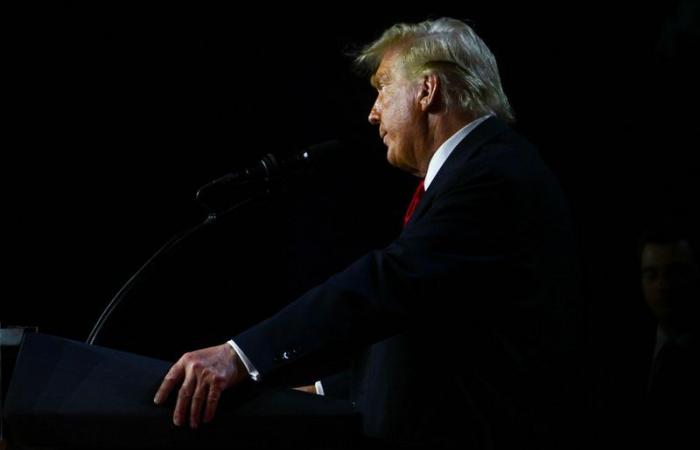Mike Dolan provides an update on the US and global markets for the day ahead.
Donald Trump’s surprisingly large victory in the US presidential election has electrified the US dollar – perhaps to its own detriment – and the US currency is aiming for its biggest one-day rise in two years.
Even before the official results are in, Mr. Trump’s virtually assured victory in key states and in the national popular vote appears far more resounding than the close race predicted just yesterday by opinion polls and betting markets. His Republican Party also won the Senate, as expected, but a complete sweep of Congress is not yet possible, as the House of Representatives remains too close to be determined and could go to the Democrats.
Stock futures and Treasury yields immediately jumped on the announcement of the results, whose apparent clarity came as a relief to some who feared days, if not weeks, of political and legal wrangling over contested votes.
Small-cap stocks grouped in the Russell 2000 index have been the stock index’s biggest gainers so far, rising nearly 6% before the whistle blew on Wednesday.
The tech-heavy S&P500 and Nasdaq futures were both up almost 2% and, significantly, the clear result saw the VIX “fear index” of stock volatility plunge to its lowest level in more than a month, falling below historical averages.
Wary of a new fiscal stimulus via the tax cuts promised by Trump, which would come on top of a budget deficit of 6% of GDP, Treasuries took a hit, the benchmark 10-year yield reaching its highest level since July, at just under 4.5%.
However, the possibility of a Democratic-dominated House and resulting gridlock, as well as the likelihood of a second Federal Reserve interest rate cut on Thursday, limited Treasury losses for the moment.
The fate of the House could now dictate the extent of future bond market losses – with the lingering possibility of a “red sweep” underscoring speculation over tax cuts.
Falling U.S. crude prices, driven in part by Trump’s enthusiasm for increased oil drilling but also by rising domestic inventories and a rising dollar, also helped preserve oil prices. bonds bruised to some extent.
Other so-called “Trump” trades reacted as expected, with bitcoin gaining as much as 8% to new records as the results were announced and digital currency bettors rejoicing at the likely easing of regulations of the cryptocurrency market by the next president.
Shares of Trump Media & Technology are up more than 50%. Tesla shares, meanwhile, jumped 12%, with billionaire boss Elon Musk, who supports Trump, recently being promised a role at the head of a government commission on energy efficiency by the likely new president.
But the dollar’s surge around the world has been remarkable – its index gains of almost 1.5% at one point helped push gains against the euro and Japanese yen to four-month highs, while the Mexican peso hit two-year highs and the Chinese yuan reached its best levels since early August.
Regardless of the outcome in the House of Representatives, Trump’s independent control of trade policy and his promise to increase tariffs against China and the rest of the world are seen as positive for the dollar by reducing the trade deficit and increasing domestic consumer prices.
Data on Tuesday showed the overseas trade deficit rose 19% in September to $84.4 billion, the highest level since April 2022, as imports jumped 3% to the record figure of 352.3 billion dollars.
But as Mr. Trump inherits a robust economy, stocks are rising and Treasury yields are rising due to his loose fiscal policy, the dollar’s gains have been reinforced, even as Mr. Trump and his Advisors generally advocate a more flexible exchange rate to flatter trade competitiveness.
In the short term, the latest surveys of the US services sector for the past month showed buoyant pre-election activity, although prices remained stable, and earnings growth for S&P500 companies is well above forecasts for the third trimester.
While futures markets remain confident of a quarter-point interest rate cut from the Fed on Thursday, prices are now only pointing to a 90 basis point reduction over the next year. This would give an implied “final rate” for the Fed cycle as high as 3.75% – almost a percentage point above what Fed policymakers themselves had indicated when they cut rates. rate for the first time in September.
Aside from currencies, foreign stock markets were mostly positive as the results of the US election developed.
Mainland Chinese and Hong Kong stocks, which await key guidance on Chinese government policy also this week, were the biggest underperformers and lost 0.5% and 2.6% respectively on concerns regarding customs tariffs. South Korea’s Kospi index also lost 0.5%.
However, helped by a weaker yen, Japan’s Nikkei jumped 2.6% and Euro and British stocks gained more than 1% each.
Perhaps most notable is the decline in eurozone government bond yields, which contrasts sharply with the rise in equivalent U.S. Treasury bonds. Indeed, the darker outlook for global trade and divergent fiscal projections on both sides of the Atlantic have widened economic gaps and performance gaps on both sides of the ocean.
The wavering of Germany’s coalition government is also adding to concern in the euro zone, amid speculation that early elections will be held there.
Key developments expected to provide more direction to U.S. markets later on Wednesday:
* Results of the presidential and legislative elections in the United States.
* The Federal Open Market Committee of the US Federal Reserve begins a two-day meeting.
* The US Treasury auctions $25 billion in 30-year bonds.
* Results of US companies: Qualcomm, Gilead, Ameren, Mckesson, Albemarle, Sempra, Corteva, Atmos, CVS, Howmet, STERIS, ANSYS, Take Two, Host Hotels, Match, Williams, PTC, APA, Iron Mountain, Marketaxess, Cencora , Trimble, American Electric Power, Pinnacle West, Charles River, Johnson Controls, etc.
* Christine Lagarde, President of the European Central Bank, and Luis de Guindos, Vice-President of the ECB, speak.






